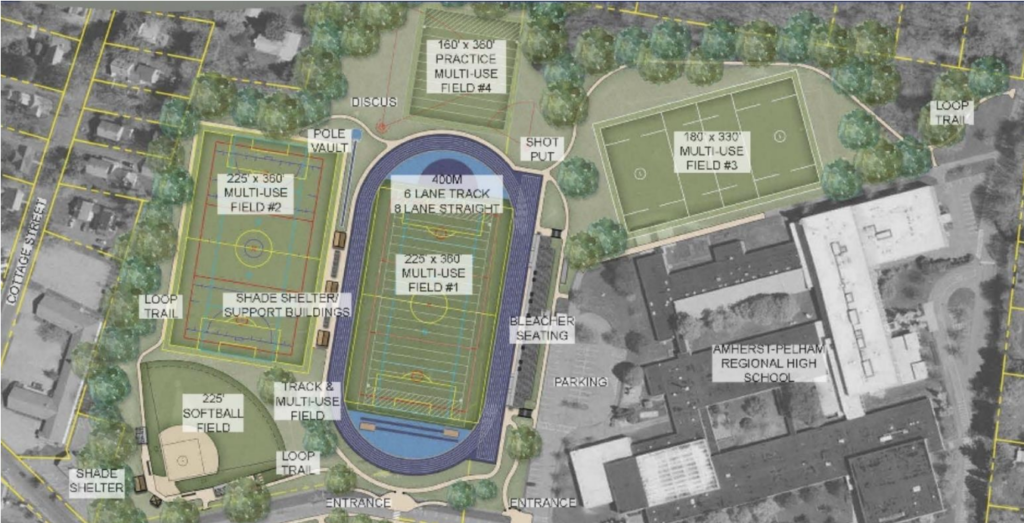Issues & Analyses: Improving The Regional Playing Fields: A Deeper Dive

A possible athletic field layout from Weston and Sampson's 2019 Athletic Fields Strategic Plan. Photo: amherstma.gov
There are sufficient grass playing fields at the Amherst-Pelham Regional middle and high schools to support our student athletes. Arguments that only the installation of an artificial turf field can meet students’ needs misinterpret the data and make erroneous assumptions about playable hours and maintenance of both types of fields. An analysis of the data provided by the Amherst Recreation Working Group and information about proper grass field management demonstrate that the district’s needs can be better, and more affordably, met by correctly addressing the current grass fields.
Unrealistic Artificial Turf Expectations
Artificial turf fields have the potential for somewhere between 2000 and 3000 playable hours annually according to Weston and Sampson, the consultants hired by the Regional School District to provide options and cost estimates. If the fields are used, as is advertised, from March through December, that comes out to between 7 and 10 hours every single day. But what does that actually look like?
On school days, that would mean having field lights on and teams playing well into the night, every night, in a residential neighborhood. More usage also means more maintenance: grooming every 100 hours of use, replenishment of infill, disinfection, inspection and repair of seams, etc. That considerable use requires time, staffing, and money and shortens the lifespan of the turf which needs to be replaced at least every 8-10 years with average use. Notably, there has been no planning on how to pay for the specialized equipment for this maintenance or disposal/replacement, even though the consultants note that the life cycle costs for artificial turf far exceed that of grass fields.
Underestimation Of Grass Field Performance
While Weston and Sampson have cited anywhere from 500 to 800 annual playable hours for grass playing fields, sources with direct experience in grass field maintenance offer evidence of between 800 and 1050 annual playable hours. Employing organic maintenance has even produced 1860 annual playable hours on a grass athletic field.
Neither the Regional School Committee, the Amherst Regional Schools’ district leadership, nor the Town of Amherst (which currently maintains all these fields) has sought an assessment or recommendation for a proper, comprehensive program from a professional grass athletic field maintenance company. The Amherst Department of Public Works is tasked with taking care of all these fields but does not have the experience, staffing, or budget necessary to do so. They have been set up to fail and comparing the existing poor conditions of our grass fields to a new artificial turf field is misleading.
Data On Actual Use Prove That Grass Fields Meet Our Needs
Proponents of artificial turf have repeatedly stated that our fields are “overused by 150% of their capacity”. The data, and the consultants, tell a different story. The Weston & Sampson Athletic Facilities Strategic Plan (see p.16) states that “Weston & Sampson concludes that some of the fields are used more than 150% of their safe use annually” and also notes that “some fields were used over 600 hours each and some under 200 hours annually” (bold mine). The minutes from the February 2018 meeting of the Amherst Center Recreation Working Group noted that the needs assessment “Found that very few fields are overused based on hours of usage but need reconfiguration to make best use (sic) fields.”
Appendix B from the Recreation Facilities Study provides details of the usage of each of the District’s 8 playing fields and 4 baseball/softball diamonds. With the exception of the field interior to the track, the hours per multi-use field ranged from 245 to 645, well within the expected capacity of grass fields. The outlier is the ARHS track and field, with 952 annual hours. However, the activities listed here include 272 hours by cross country and track & field (with many of these activities occurring on the track), while soccer, ultimate, and PE classes accounted for 680 hours on the track’s interior field.
An Alternative Strategy
There is a solution that would provide more improved fields at a lower cost and in a shorter time frame.
The total annual use hours for the track and field plus two adjacent multi-use fields to the north and northeast total to ~1600 hours (including the track), or an average of ~536 hours/field, easily achievable with grass fields by all accounts. Weston and Sampson’s inflation adjusted cost estimate for Option 2 (track and field project with grass interior) plus renovation of these two other fields is less than even the original (2021 figure) cost of Option 3 ($4.7M) and far less than its adjusted construction estimate of at least $5-6 million. This approach would also provide three improved fields with a total of nearly 210,000 square feet, as opposed to one 91,000 square foot field.
If these three fields were improved and maintained to be playable at even 800 hours annually, this would provide a total of about nine hours of play every day but spread out over three fields and allowing for multiple simultaneous users/sports. The only advantage left for artificial turf is that fields would likely be playable earlier in the spring, although proper drainage and stormwater management would mitigate further against this difference.
The Solution: Improve Natural Turf Maintenance
Finally, while the debate is currently focused on the type of field surface, the underlying problems are not being discussed or addressed. Professional athletic field groundskeeping consultation and supervision of the creation and implementation of a proper field use policy and ongoing maintenance practices for all the fields (in the district and town) is required. This is true no matter what type of field is used and needs to apply to all the playing fields. Moreover, failure to assess and address any water drainage issues prior to construction of the track and field would risk damage to this asset.
